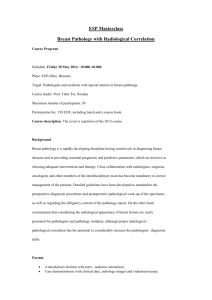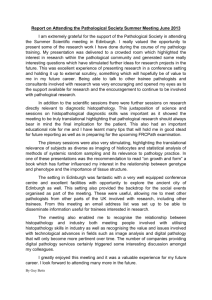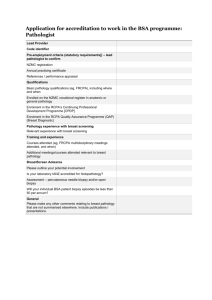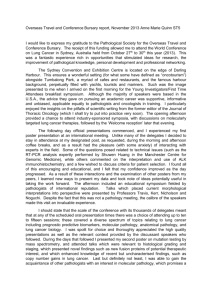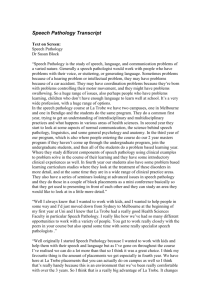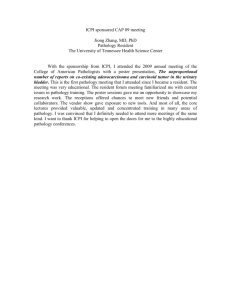2012 - The Pathological Society of Great Britain & Ireland
advertisement
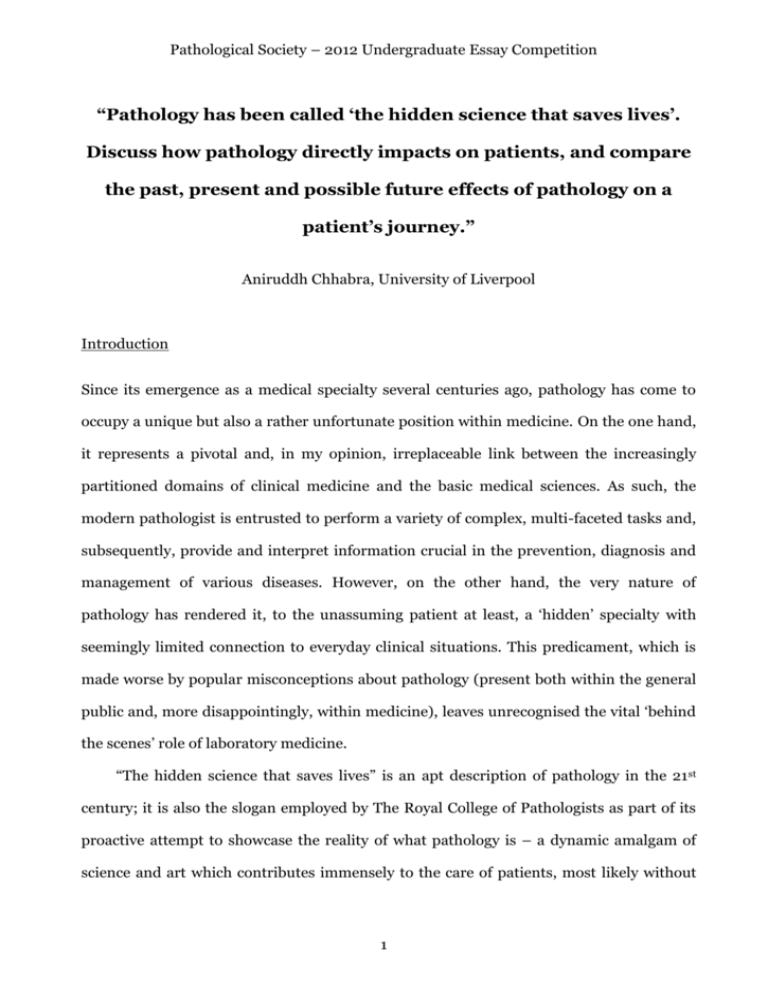
Pathological Society – 2012 Undergraduate Essay Competition “Pathology has been called ‘the hidden science that saves lives’. Discuss how pathology directly impacts on patients, and compare the past, present and possible future effects of pathology on a patient’s journey.” Aniruddh Chhabra, University of Liverpool Introduction Since its emergence as a medical specialty several centuries ago, pathology has come to occupy a unique but also a rather unfortunate position within medicine. On the one hand, it represents a pivotal and, in my opinion, irreplaceable link between the increasingly partitioned domains of clinical medicine and the basic medical sciences. As such, the modern pathologist is entrusted to perform a variety of complex, multi-faceted tasks and, subsequently, provide and interpret information crucial in the prevention, diagnosis and management of various diseases. However, on the other hand, the very nature of pathology has rendered it, to the unassuming patient at least, a ‘hidden’ specialty with seemingly limited connection to everyday clinical situations. This predicament, which is made worse by popular misconceptions about pathology (present both within the general public and, more disappointingly, within medicine), leaves unrecognised the vital ‘behind the scenes’ role of laboratory medicine. “The hidden science that saves lives” is an apt description of pathology in the 21 st century; it is also the slogan employed by The Royal College of Pathologists as part of its proactive attempt to showcase the reality of what pathology is – a dynamic amalgam of science and art which contributes immensely to the care of patients, most likely without 1 Pathological Society – 2012 Undergraduate Essay Competition them realising it – and to banish the ill-conceived perceptions of pathology being an isolated and immaterial entity which deals solely with death1. This is certainly not a small task and perhaps the best way of informing the public is to remind ourselves of how the different aspects of pathology relate to and affect the lives of so many individuals on a day-to-day basis. This essay intends to do just that and begins by briefly contemplating how the remarkable evolution of pathology has influenced the structure and practice of patient care since the days of Hippocrates. Pathology through the years Simply put, pathology is the study of disease; therefore, locating a specific point in history which marked its ‘beginning’ is impossible as humans have always questioned and enquired about their ailments, investigating the origin of disease as far as the resources at their disposal would allow. Nevertheless, modern pathology has its roots in the pioneering work of Morgagni in the 18th century, who developed the concept of clinicopathological correlation through his meticulously detailed autopsy studies2. His findings and the invention of the compound microscope provided the foundation for Virchow and others to study disease mechanisms (e.g. inflammation, necrosis, etc) at the cellular level. This provided the impetus for morphology based identification and classification of diseases, and also enabled other significant advances in medicine to be made. For example, Landsteiner proposed what is now the ABO blood group system in 1901 and drastically improved the success rate of blood transfusions, saving countless lives since3. Although succinct, the clichéd description of a pathologist being a “doctor’s doctor” is incomplete as it neglects to disclose the fact that a pathologist, along with being a scientist and an educator, is also a physician directly responsible for patient care. In the last century, the development of new technologies (e.g. immunohistochemistry, gene expression profiling, etc) and our improved understanding of how different organs and 2 Pathological Society – 2012 Undergraduate Essay Competition tissue types can be affected by a single disease has allowed pathology to encompass different fields (e.g. immunology, microbiology, etc). This has benefited patients as they can now receive care from a highly specialised, multi-disciplined team of physicians. For example, the specialist input of chemical pathologists and toxicologists may be needed by a rheumatologist in interpreting the biochemical and liver function tests of a seriously ill rheumatoid arthritis patient on disease-modifying anti-rheumatic drugs. Similarly, improvements in existing and the discovery of new staining techniques have regularly punctuated the history of pathology, facilitating the management of many diseases. For example, the invention of Gram staining provided inroads to the development of a clinically meaningful classification of bacteria based on cell wall types, in turn improving the characterisation of different antibiotics and their spectrum of action4. Pathology and malignant neoplastic diseases Pathology has always had an intimate focus on neoplastic diseases and, unsurprisingly, advances in our understanding of how cancer arises have closely followed technological advances in the field of pathology. The autopsy has remained a time-tested tool for documenting the gross appearance of solid cancers and has been valuable in informing us of the natural history and metastatic patterns of many cancers5. It has also allowed pathologists to characterise tumours phenotypically and immunohistochemically, which has facilitated their understanding at the sub-cellular level. Despite their declining usage, post-mortems still have an important role in educating clinicians and improving their patient care. A situation which exemplifies this is the unexpectedly high incidence of latent cancers, lacking clinical concordance, found at autopsy and its subsequent implications, for example on organ donation6. Histopathological examination of biopsy tissue is the gold standard for diagnosing most cancers. Here, the histopathologist is tasked with using their knowledge and 3 Pathological Society – 2012 Undergraduate Essay Competition expertise to judge whether individual cells (and their organelles) are abnormal and deranged such that they are ‘cancerous’. Today, pathological observations form not only the foundation of cancer diagnosis but, through prognostication and prediction, also directly influence treatment decisions. Indeed, this is in quite stark contrast to the laboratory-based physician of the 1970s, whose duties in clinical oncology seldom extended beyond making a definite diagnosis (itself not an easy task). This is perhaps a reflection of a recurring theme in the history of pathology – that of selective change. As a scientific discipline, pathology has always been reliant on a variety of tools and technologies, and the rapidity of technological advances in the last century or so would apparently have been of great benefit to the field. It may be surprising to note then that, historically, the uptake of new technologies has been especially slow in pathology; this peculiar state of reluctance is affirmed, for example, by the 150 or so years which passed between the invention of the compound microscope and its widespread use in diagnostic pathology or by the delay in utilising the polymerase chain reaction (PCR)7. Although this approach certainly belies the drastic transformations which have occurred in the role of the clinical pathologist, just in the last few decades, it is better described as being prudent rather than ignorant. This is understandable because conventional pathology, at any given period in time, has always possessed techniques (e.g. the humble hematoxylin & eosin [H&E] stained slide) which arguably provide the most definite, pragmatic and practical answers to questions of clinical significance. Thus, careful and watchful appraisal of new technologies, no matter how innovative they are claimed to be, has been an important feature in the evolution of pathology and one which has brought significant benefits to cancer patients. These benefits are especially clear for breast cancer. Initially, the drawbacks of obtaining large excised specimens and carrying out gross pathologic observations (e.g. to ascertain tumour size, vascular invasion, etc) provided the impetus for utilising and 4 Pathological Society – 2012 Undergraduate Essay Competition improving imaging procedures (e.g. ultrasound) and minimally invasive techniques for studying breast tumours. This allowed pathologists to obtain smaller samples of diseased tissue (e.g. using ultrasound-guided core biopsy) and spearhead the classification of both benign and malignant breast neoplasms through their study of various microscopic features, such as mitotic activity, tubule formation, nuclear and cellular pleomorphism, and microscopic lymphovascular invasion. The Scarff-Bloom-Richardson histological grading system was developed to evaluate these pathological parameters and provide (crude) prognostic information based on how well differentiated invasive breast carcinoma cells were to their normal counterparts8. This was a significant step in answering a patient’s most important questions – about survival – and in placing pathologists at the helm when it came to making treatment decisions, especially about adjuvant therapy, with patients and their oncologists. Subsequent refinements to this system and the incorporation of two independent prognostic factors (nodal stage and tumour size) paved the way for widespread use of the Nottingham Prognostic Index (NPI) as a method of predicting survival of operable primary breast cancer9. This is a continuous variable which reflects the growth rate, metastatic potential and genetic derangement of invasive breast cancers, with the index defining three categories of prognosis (good, moderate and poor) and survival probability10. A needle biopsy, used to obtain tissue samples (or flee floating cells), has important limitations which the histopathologist must circumvent in order to provide informative diagnostic and prognostic information. As human malignancies tend to be spatially heterogeneous, a single sample of a suspect mass may not reveal any abnormalities. Similarly, examining several samples may lead to the identification of a continuum of abnormalities, giving conflicting information11. The NPI algorithm takes into account the lymph node status, a parameter which has been shown to possess great prognostic value and is also used in other cancer staging systems (e.g. tumour, node, metastasis (TNM) system)12. Histopathology has always 5 Pathological Society – 2012 Undergraduate Essay Competition played an important role in this assessment and, nowadays, sections of a sentinel axillary lymph node (obtained, for example, during lumpectomy surgery) can be examined under the microscope to detect cancer cells indicating nodal spread of the primary cancer. This task has gained added importance over the years as many other variables (e.g. histological grade, morphometric nuclear factors) are now seen to be of limited long-term prognostic value13. In the last decade or so, pathologists have been able to better identify micrometastases (cancerous growths smaller than 0.2 mm) in lymph node tissue and have played a key part in determining the prognostic value of this finding in patients. This has required close co-operation between pathologists, cancer surgeons and oncologists as conclusive evidence of the benefit of axillary lymph node dissection (ALND) in patients with micrometastases has been lacking14. As ALND carries with it a significant risk of lymphoedema, nerve damage and shoulder dysfunction, this situation illustrates the immense, but seemingly ‘hidden’, impact of a pathologist’s clinical judgement in multidisciplinary decision making, which must finely balance the risk of cancer recurrence against that of a significantly impaired quality of life for the patient. Drug discovery and development In the bygone decades, pathology has established itself as an indispensable component in the discovery and development of new drugs. These are time-consuming and expensive endeavours and pathologists play a key role in ensuring that they arise logically from our current understanding and assumptions of disease processes. Tissue-based preclinical research, carried out by toxicologic, human anatomy and veterinary pathologists, continues to provide major insights into the mechanism of candidate drugs and their efficacy and toxicity profiles. This work most resembles ‘classical’ pathology and is primarily based around studying the morphological changes that are induced in various 6 Pathological Society – 2012 Undergraduate Essay Competition animal tissues by the compound(s) under consideration. The sequencing of the human genome has allowed better characterisation of the activities of genes and their protein products in the pathogenesis of various conditions. This, along with new molecular-based approaches, now permits the identification of molecular targets which can be therapeutically acted upon by specific compounds, selected by screening large databases of synthetic and natural compounds. Molecular pathology can replace the traditional empirical approaches to drug discovery and, thus, it has the potential to improve considerably the effectiveness of new drugs (i.e. improved selectivity) and the efficiency of their development. Going above and beyond H&E The molecular age we now find ourselves in has seen the future roles of conventional pathology be questioned many a time15. While many prophecies – including “the microscope will be in a cupboard gathering dust in a few years’ time” – can be dismissed as harmless hyperbole, it is worth noting (and admiring) the strong foundations pathology has laid down in its long history and how these have helped to refine the field in the face of new challenges. In 1932, Dr Cuthbert Dukes published his staging system for colorectal carcinoma based on his meticulous histopathological observations of tumour invasion through the three layers of the bowel wall16. Although this has largely been superseded by other standardised systems (e.g. the TNM system mentioned earlier), it represents a key initiating event in the elucidation of the various pathogenetic pathways involved in the colorectal adenoma-adenocarcinoma sequence17. This achievement would also not have been possible without the synergistic integration of conventional pathology and molecular-based approaches. In the last decade or so, these approaches have been pivotal in advancing the notion of “personalised” medicine. For continuity, I will use the example of breast cancer to 7 Pathological Society – 2012 Undergraduate Essay Competition consider how patients are, and will continue to be, affected by this “paradigm” shift in medicine. As already discussed, pathology plays an integral role in the diagnosis of breast cancer and also significantly influences management decisions. However, in the last few decades, growing frustration over the limitations (narrow therapeutic indices, toxicities, etc) of empirical chemotherapy and radiotherapy meant that there was a dire need for more focused treatment options for this heterogeneous disease. To complement this, more reliable means of identifying and stratifying patients who might benefit from particular treatment regimes were also needed. A useful contribution to solving this conundrum was provided by sensitive immunohistochemical (i.e. use of labelled antibodies to locate an antigen of interest) techniques which have thus far helped in the identification of dozens of prognostic biomarkers. The expression status for three such molecular markers – oestrogen receptor (ER), progesterone receptor (PR) and human epidermal growth factor receptor 2 (Her2) – is now routinely determined by immunostaining to guide treatment for all invasive breast carcinomas. The importance of oestrogen in the development and progression of breast cancer has long been recognised and, starting with bilateral oophorectomies, many anti-oestrogen therapies have been attempted. Tamoxifen, a selective ER modulator which prevents stimulation of oestrogensensitive tumours, has reduced breast cancer-specific mortality by 31% and has extended disease-free survival for millions of women18,19. This, along with the success of other hormonal therapies (e.g. aromatase inhibitors), means that ER status determination is now part of the minimum pathology dataset for breast cancer20. Similarly, establishing overexpression of Her2 has become essential as this indicates a poorer prognosis and is a prerequisite for adjuvant therapy with the monoclonal antibody, Herceptin (trastuzumab). Although quantitative immunohistochemistry is the cheapest and most convenient method of determining their ER, PR and Her2 status, problems in achieving standardised protocols (e.g. duration of tissue fixation prior to analysis) have limited its 8 Pathological Society – 2012 Undergraduate Essay Competition consistency and reliability. Fluorescence and silver-enhanced in situ hybridisation (FISH and SISH) are more objective, sensitive and specific, but also more expensive alternatives available to pathologists21. These techniques are also useful in guiding treatment for many other diseases (e.g. anti-CD20 antibodies in B-cell lymphoma). Immunohistochemistry has also played a prominent role in improving diagnostic certainty in every day clinical practice, as the following breast pathology example illustrates. Stromal invasion has long been recognised as an important feature in distinguishing between invasive (infiltrating) carcinoma and carcinoma in situ (and other benign lesions). In the latter case, the epithelial cells lining the ducts and acini of the breast are separated from the surrounding connective tissue by a continuous basement membrane and a stretch of myoepothelial cells. This is not the case for invasive carcinoma (and one benign exception: microglandular adenosis). However, the assessment of stromal invasion on standard H&E sections not infrequently reveals an uncertain result. For example, patchy periductal inflammation and sclerosis may distort the appearance of an otherwise ‘typical’ high grade ductal carcinoma in situ, leading to the lesion being misdiagnosed as an invasive carcinoma. Antibodies to basement membrane components (e.g. laminin) were initially utilised to manage such situations but their use waned quickly as it emerged that the synthesis of some of these basement membrane components was not completely absent in cancer cells22. Since then, highly sensitive markers for proteins present in breast myoepothelial cells (e.g. calponin, p63, etc) have been in common use and more specific markers continue to be sought23. Breast cancer can now also be systematically classified based on gene expression profiles (determined using microarray-based gene expression analysis)24. This molecular approach separates breast cancer into several subtypes (triple negative/basal like, luminal A, etc) and has the potential to provide better risk stratification and more patient-specific prognostic information than the current methods. However, no clinically acceptable 9 Pathological Society – 2012 Undergraduate Essay Competition method currently exists to implement such an approach, although correlating and cataloguing the morphological features of breast tumours with their gene expression profiles may be a useful indirect way of utilising this powerful achievement in molecular pathology in the near future25. Conclusion Despite its perceived invisibility, pathology permeates into all branches and is the bedrock of modern medicine. Over time, pathologists as scientists and educators have provided other medical disciplines with an understanding of mechanisms of various diseases and the physiologic basis of signs and symptoms. Armed with an inquisitive mindset and a formidable array of technologies, pathologists have for a long time complemented the typical doctor-patient relationship and have drastically, but with some subtlety, shortened the duration of a patient’s journey through healthcare. This is particularly true for cancer where pathologists hold most influence, and the status quo will continue as the timetested methods of pathology become integrated with the unprecedented advances in genomics and proteomics. This, along with digitalisation of pathology and greater international integration and corroboration between pathologists, will be beneficial in other areas too, especially drug development. Of course, in an age of financial austerity, it should be remembered that pathology is not immune to external drivers of change. Thus, as the most recent Carter review identified, pathology services must remain innovative, modernise and become more efficient despite resource constraints26. Personally, I foresee pathology moving forward and blending seamlessly with the new generation of diagnostics and therapeutics, carrying on the trend for adaption and self-improvement it has silently established for itself over centuries. 10 Pathological Society – 2012 Undergraduate Essay Competition References The Royal College of Pathologists Patient Resources – Pathology: The Hidden Science That Saves Lives. Accessed: 28th August 2012. Available from: http://www.rcpath.org/patient-resources/pathology-the-hidden-science-that-saves-lives 2 McLendon WW. A historical perspective as a compass for the future of pathology. Arch Pathol Lab Med. 1986; 110(4): 284-288. 3 NNDB – Karl Landsteiner. Accessed: 28th August 2012. Available from: http://www.nndb.com/people/698/000091425/ 4 Newcastle University – The Gram Stain. Accessed: 28th August 2012. Available from: http://www.ncl.ac.uk/dental/oralbiol/oralenv/tutorials/gramstain.htm 5 Leong SP, Cady B, Jablons DM, Garcia-Aguilar J, Reintagen D, Werner JA, et al. Cancer Treat Res. 2007; 135: 209-221. 6 Sens MA, Zhou X, Weiland T, Cooley AM. Unexpected neoplasia in autopsies: potential implications for tissue and organ safety. Arch Pathol Lab Med. 2009; 133(12): 1923-1931. 7 Wall DP, Tonellato PJ. The future of genomics in pathology. F1000 Med Rep. 2012; 4(1): 4. 8 Bloom HJ, Richardson WW. Histological grading and prognosis in breast cancer; a study of 1409 cases of which 359 have been followed for 15 years. Br J Cancer. 1957; 11(3): 359-377. 9 Lee AHS, Ellis IO. The Nottingham prognostic index for invasive carcinoma of the breast. Pathol Oncol Res. 2008; 14(2): 113-115. 10 Kollias J, Murphy CA, Elston CW, Ellis IO, Robertson JF, Blamey RW. The prognosis of small primary breast cancers. Eur J Cancer. 1999; 35(6): 908-912. 11 Houssami N, Ciatto S, Ellis I, Ambrogetti D. Underestimation of malignancy of breast core-needle biopsy: Concepts and precise overall and category-specific estimates. Cancer. 2007; 109(3): 487-495. 12 Lipponen P, Aaltomaa S, Eskelinen M, Kosma, VM, Marin S, Syrjanen K. The changing importance of prognostic factors in breast cancer during long-term follow-up. Int J Cancer. 1992; 51(5): 698-702. 13 Leong ASY, Lee AKC. Biological indices in the assessment of breast cancer. Clin Mol Pathol. 1995; 48: M221-M238. 14 Rowan K. Micrometastases in sentinel lymph nodes: few data make for hard decisions. J Natl Cancer Inst. 2009; 101(20): 1374-1376. 15 Moch H, Blank PR, Dietel M, Elmberger G, Kerr KM, Palacios J. Personalised cancer medicine and the future of pathology. Virchows Arch. 2012; 460(1): 3-8. 16 Dukes CE. The classification of cancer of the rectum. J Pathol Bacteriol. 1932; 35(3): 323-340. 17 Leslie A, Carey FA, Pratt NR, Steele RJ. The colorectal adenoma-adenocarcinoma sequence. Br J Surg. 2002; 89(7): 845-860. 18 Early Breast Cancer Trialists’ Collaborative Group. Effects of chemotherapy and hormonal therapy for early breast cancer on recurrence and 15-year survival – an overview of the randomized trials. Lancet. 2005; 365(9472): 1687-1717. 19 Jordan VC. Tamoxifen: a most unlikely pioneering medicine. Nat Rev Drug Discov. 2003; 2(3): 205-213. 20 The Royal College of Pathologists Datasets and Tissue Pathways – Breast. Accessed: 28th August 2012. Available from: http://www.rcpath.org/publicationsmedia/publications/datasets/breast.htm. 1 11 Pathological Society – 2012 Undergraduate Essay Competition Leong AS, Zhuang Z. The changing role of pathology in breast cancer diagnosis and treatment. Pathobiology. 2011; 78(2): 99-114. 22 Willebrand D, Bosman FT, De Goeij, AFPM. Patterns of basement membrane deposition in benign and malignant breast tumours. Histopathology. 1986; 10(12): 1231-1241. 23 Wang NP, Wan BC, Skelly M, Frid MG, Glukhova MA, Koteliansky VE, et al. Antibodies to novel myoepithelium-associated proteins distinguish benign lesions and carcinoma in situ from invasive carcinoma of the breast. Appl Immunohistochem. 1997; 5(3): 141-151. 24 Perou CM, Sorile T, Eisen MB, Van De Rijn M, Jefrey SS, Ress CA. Molecular portraits of human breast tumours. Nature. 2000; 406(6797): 747-752. 25 Fadare O, Tavassoli FA. The phenotypic spectrum of basal-like breast cancers: A critical appraisal. Adv Anat Pathol. 2007; 14(5): 358-373. 26 Department of Health Pathology – Independent reviews of NHS pathology services. Accessed: 28th August 2012. Available from: http://webarchive.nationalarchives.gov.uk/+/www.dh.gov.uk/en/Healthcare/Path ology/DH_075531 21 12
